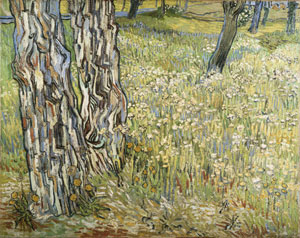- Tree Trunks in the Grass, 1890
If you’re in the Ottawa area, or feel like a trip to the nation’s capital, catch the Van Gogh at the National Gallery. Running there until Sept. 3, it is a remarkable display of his landscape and Nature paintings. Viewing it is a moving and exhilarating experience. It is most certainly worth the trip. Gazing on one painting after another, it is hard not to feel that Van Gogh’s art simply towers over that of his many great contemporaries. It is the prophetic quality that makes the difference. Like that of the equally visionary film-maker Andrei Tarkovsky, Van Gogh’s relationship to Nature is emotional and hallucinatory. It ccnfronts us with what our mind-forged manacles prevent us from ever seeing. What George Eliot says in Middlemarch–of what it would be like to have a completely unfiltered empathy for other human life–might equally be applied to Van Gogh’s perception of Nature: “If we had a keen vision and feeling of all ordinary human life, it would be like hearing the grass grow and the squirrel’s heart beat, and we should die of that roar which lies on the other side of silence.”
You can find the gallery’s description of the exhibition here, and a CBC review here:
Here are some excerpts from Frye on Van Gogh:
What’s transcendental in Blake is not the statically geometrical, but the sense of arrested energy: the wriggling vines & snakes, flames & the like. This is what I meant earlier in talking of his Van Gogh classicism. It’s an expression of the belief that every object is an event. (CW 9, 14)
The word “reality” should not mean statically a certain form of what is perceived, but dynamically a quantum, a certain charge or energy of perception–in practice, I suppose, the minimum consistent with consciousness. Any change of perception over that contains an element which is unreal in some contexts and a greater reality in others. As unreal, it’s generally called subjective, or perhaps emotional, or sometimes imaginary; as more real, it’s imaginative or creative.
This is pure Blake–I’ll never get out of that framework, I suppose–also Shelley’s doctrine of poetry as the overcoming of the inertia of habit. (Whether Wiener’s formula that communication overcomes entropy is anything more than a vulgarization of this I don’t know.) Anyway. I got this, as usual, through the back door: remembering that very unpleasant book, The Story of O, it seemed to me that no actual woman’s body could bear that charge of fetishism: it’s only in fantasy that all that flogging & branding & chaining could exist as an experience with its own kind of reality.
Creatively, of course, the surcharge of reality takes the hallucinatory form of Van Gogh’s sunflowers. That kind of excess is acceptable as potentially real; but the question remains unsolved: to what extent, & in what sense, is it actually there? Probably if I knew that I’d know too much to want to write books. However, the objective world is only “material”: it’s there, but it could be there in a great many different forms and aspects. I suppose even here there [are] still possibilities: it can’t be just anything. But perhaps extracting a finite schema from the variety of mythologies, literatures, or religions might contribute something to the understanding of what some of these possibilities could be. The individual can’t create his own world, except in art or fantasy: society can only create a myth of concern. What fun if one could get just a peep at what some of the other worlds are that a new humanity could create–no, live in. (CW 9: 287-288)
The fact that creative powers come from an area of the mind that seems to be independent of the conscious will, and often emerge with a good deal of emotional disturbance in their wake, provides the chief analogy between prophecy and the arts. The creative people that we most instinctively call or think of as prophetic, Nietzsche, Rimbaud, Blake, Van Gogh, Dostoevsky, Strindberg, show the analogy very clearly. Some people pursue wholeness and integration, others get smashed up, and fragments are rescued from the smash of an intensity that the wholeness and integration people do not reach. (CW 18: 164)
Realism is often associated with, and often rationalized as, a scientific view of the world, but the impetus behind realistic art, good or bad, is of social and not scientific origin. There is a curious law of art, seen in Van Gogh and in some of the Surrealists, that even the attempt to reproduce the act of seeing, when carried out with sufficient energy, tends to lose its realism and take on the unnatural glittering intensity of hallucination. (CW 27 “Design as a Principle in the Arts” 232)
